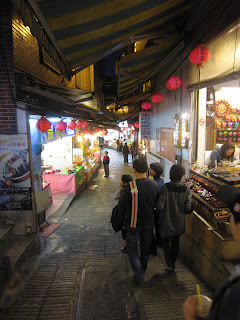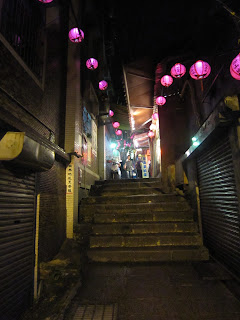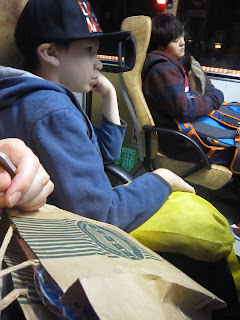Jinguashi (金瓜石) and Jiufen (九份) are famous old goldmining towns up on the north-east coast of Taiwan. The story goes that when they were building a railway bridge across the river in nearby Ruifang, one of the labourers had worked on the goldfields in California and Australia and noticed the alluvial gold in the river, leading to a local goldrush.
The goldfields were exploited on an industrial scale by the Japanese during the occupation, and most of the goldmining infrastructure in Jinguashi seems to be Japanese-era. Allied prisoners of war were held in the surrounding area during the war, and worked in the goldmines.
The mines are essentially exhausted these days, although there are apparently always flickers of interest from foreign mining companies looking to employ modern high-tech mining methods to make the remaining gold deposits economic again. When the existing mineshafts were abandoned, tailings were thrown down the shafts, leading to contamination of the ocean off Jinguashi as run-off flows through the mines and leaches out all sorts of frightening heavy metals. Bizarrely, the phenomenon, an environmental catastrophe, is something of a tourist attraction and has been given the name "Yin-yang sea" (陰陽海) for the way the different coloured waters flow together. I have sat on the beach at Jinguashi and watched a fisherman standing out in the middle of the Yin-yang Sea fishing - hopefully it was catching them and kissing them and throwing them back - but I imagine (Taiwanese being Taiwanese) the fish were headed for a kitchen table, complete with a dose of mercury, arsenic and lead. I've included a link to the satellite photo of the Yin-yang Sea
here. The satellite photo doesn't really do it justice, but you can get a sense of the amount of contamination that must be flowing down into the ocean every day.
Jiufen is a nearby hillside town that is most famous for having been the location for the movie "City of Sadness" (
悲情城市), set just after the Second World War and the end of the Japanese occupation. Jiufen was fading away after the mines shut down, but then after it featured in City of Sadness it became famous, and tourists flocked in to lap-up the town's old-world charm.
The name Jiufen is interesting - so many Taiwanese placenames hark back to the way in which the land was originally settled by the early settlers from the mainland. "Jiufen" means literally "nine shares", and is a reference to the site having originally been claimed and settled by nine families who split the land between them.
We caught a bus from Taipei and enjoyed the bus trip up towards the sea, then cutting inland behind the range of mountains on coast. We stayed on the bus past Jiufen and got off at Jinguashi, then walked down the hill to the Gold Mining Museum. Inside the museum we went on a tour of a restored Japanese-era building that would have been accommodation for the family of one of the Japanese senior officials during the Japanese-era, and later accommodation for the family of a Chinese senior manager after the end of the occupation. Different parts of the building had been restored to reflect different periods of use.
From there we wandered through the grounds of another building that was built specifically to house the Japanese Crown Prince when he came for a visit. The whole area is fairly god-forsaken at the best of times - being so exposed to the ocean, the climate would be consistently damp and cold and windy, and then during the period when the mine was working it must have been fairly grimy, so it's interesting that the Crown Prince would choose to spend enough time here to justify building a new house specifically for him. The grounds have a mini-golf course and an archery range - again built specifically for the Crown Prince.
Next we visited a mineshaft that has been kept open and restored for visitors. When we paid for admission they gave us our tickets and strange blue cloth caps, which had us completely bemused until we realised that we had to wear safety helmets in the minshaft, and the caps were helmet-liners either to prevent us from catching helmet-cooties or to prevent us from spreading our helment-cooties. The mineshaft was interesting, with displays of work-scenes using mannequins and original equipment. The displays included blasting and the security-check for the miners at the end of their shift, to make sure they weren't smuggling-out any gold.
From there we climbed up the hill to the ruins of an old Shinto temple. You can imagine that gold mining would have been a dangerous occupation, and in the face of that danger the temple would have been important to the Japanese working around the mines. Presumably the locals would have had their own temples in the town. It's difficult to get a sense of what the temple must have looked like when it was built - I am guessing it had a lot of wood in the construction, and this has all rotted-away, leaving only the stone pillars.
By the time we had come down from the temple the museum had closed, so we found a bus and headed back to Jiufen with a group of workers from the museum. We'll have to go back to see the memorial to Allied prisoners of war another time.
Jiufen is wonderful in a higgledy-piggledy sort of way. The main street is narrow and winds up and down the hillside, lined with all sorts of shops, restaurants and cafes. With all the tourist traffic since City of Sadness it has become fairly commercialised, but it still has bucket-loads of character. At the end of the main street we stopped and looked out over the coast towards Jilong / Keelung. All the streets on that side of Jiufen were an enormous expanse of flashing lights - all flashing in the same rhythm but out of sequence - I've put a short video of it
here. It was an impressive effect - we must get our local government to organise something similar with the street lights around here. I suppose it gets fairly tedious if you live in the area and have flashing lights outside your bedroom window every night.














































No comments:
Post a Comment